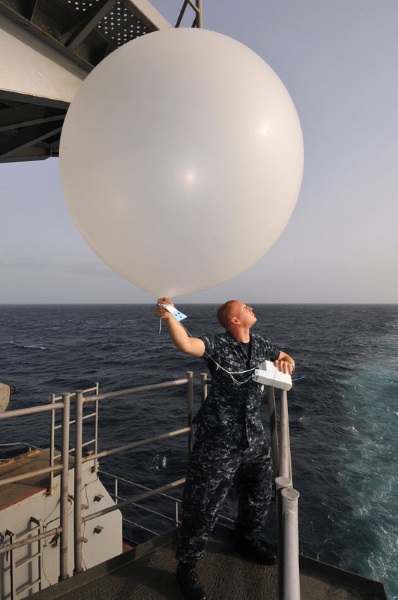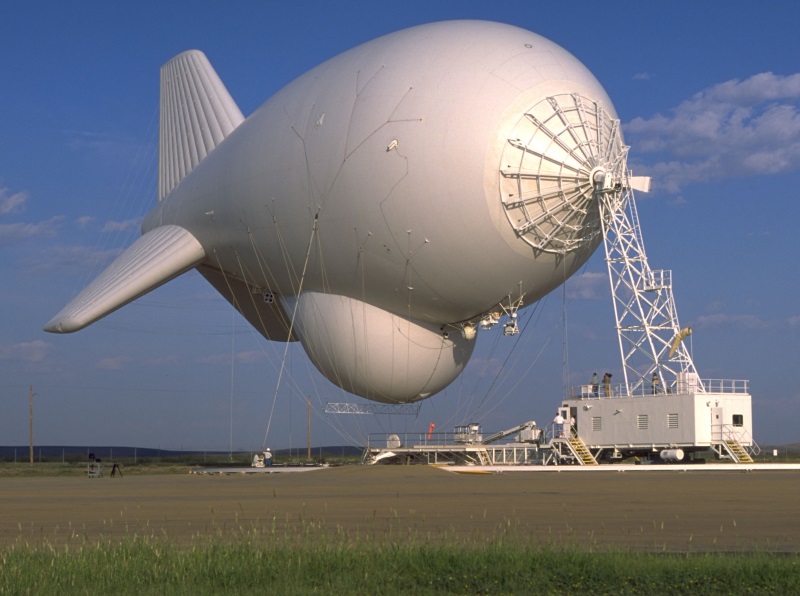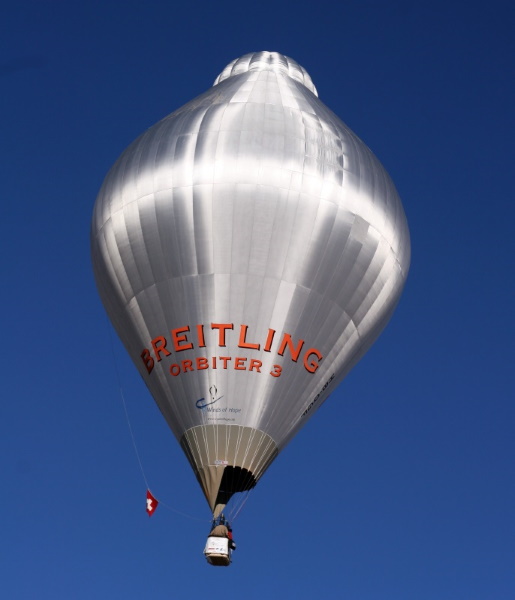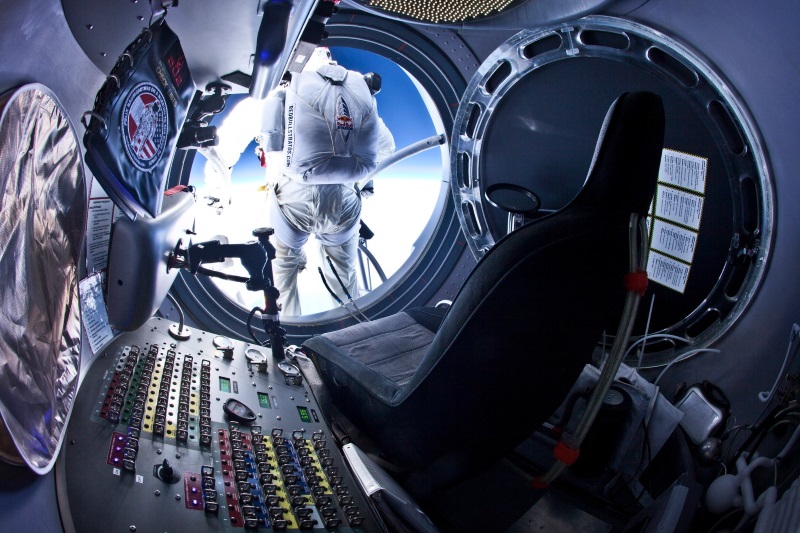
* Balloons may seem like an old-fashioned technology to most of the public, but they are alive and well. Weather balloons have been commonplace for decades, and the military still makes considerable use of them. The public is very familiar with hot-air sport ballooning, as well as with the exciting record-breaking flights across continents and oceans, using high-tech balloon technologies.
* Weather balloons are a relatively modern invention; before World War II, kites were generally used for high-altitude weather observations, but they left something to be desired. Kites required open areas for launch, they could raise hell if the tether broke, and they gradually became a hazard to aircraft navigation as air traffic increased. Kites were generally phased out of weather service in the 1930s.
By that time, balloons were also being used for weather observation on a limited basis, flying on a tether to provide data on wind direction. By the outbreak of World War II, latex balloons and compact instrument packages with radio transmitters were available, and the need to track the weather to support military operations led to the development of the weather balloon more or less as we know it now. Now, hundreds of weather balloons are launched twice a day from sites the world over. The US National Weather Service (NWS) launches tens of thousands a year. They are simple plastic balloons about two meters (six and a half feet) in diameter when inflated. They carry a radio-equipped instrument package, called a "radiosonde" or "sonde", on a line up to about 30 meters (100 feet) long to prevent the balloon from influencing the sonde's measurements.
The sonde is a styrofoam box about the size of a cigar box, with a battery-powered radio link to relay back data from its instrument suite, which usually includes humidity, temperature, and barometric sensors. The sonde's signals are also tracked to monitor wind speed and direction. The data is picked up on the ground and relayed to a central NWS facility at Camp Springs, Maryland, as well as weather centers in other nations.

The sonde is lightweight and designed to disintegrate if struck by an aircraft. There are few records of such collisions, partly because the balloons don't stay in the air lanes for long. A weather balloon will reach an altitude of about 30 kilometers (100,000 feet), where it will then burst, dropping the sonde on a red paper parachute. Not all weather balloon operators recycle the sondes since they're cheap, but the NWS does, with all the sondes fitted with a prepaid mailing bag that the finder can use to ship the package back to the NWS.
Some finders try to claim damages supposedly inflicted by the sonde, but it's so lightweight that it would, say, not make much of a bump if it hit a living-room window. However, sondes have shorted out power lines on occasion. About a quarter of the sondes are recovered, with some being recovered six or seven times, but in general reconditioned sondes are sent to island sites where they will usually be lost for good after being sent into the sky a second time.
* As a footnote to weather balloons, there was also a long-running effort to perform high-altitude weather observations with "superpressure balloons (SPB)" -- which, unlike conventional zero-pressure balloons, are sealed so they don't leak helium, giving them long endurance.
Small superpressure weather research balloons were flown from the 1960s, being labeled as "Global Horizontal Sounding Technique (GHOST)". From 1966, the US National Center for Atmospheric Research (NCAR) launched hundreds of GHOST balloons from Christchurch, New Zealand. They were made by Winzen, being spherical when full inflated, and having a diameter of 4 meters (13.1 feet); they carried a payload weighing 2.9 kilograms (6.4 pounds). They had no altitude control, simply floating up to an altitude of about 15 kilometers (50,000 feet), bobbing up and down with air pressure shifts.
They were originally tracked and monitored by radio amateurs, later by satellites with tracker payloads. Typical endurance was a few months, though at least one stayed up over two years. Thousands were launched under various programs up to about 1980, but it appears they were abandoned after that time -- being expensive, and possibly rendered obsolete by improved weather satellites. It is tempting to think that the Soviets, in their interceptions of balloon intruders, were actually chasing after GHOSTs -- but the GHOSTs weren't launched in high latitudes, and they were commanded to fall out of the sky if they strayed out of mid-latitudes.
* As another footnote, a company named Space Data has used the technology to monitor vehicles and facilities for oil companies in Texas, Oklahoma, Louisiana, Arkansas, and New Mexico. Thousands of balloons carrying a communications relay payload have been launched, day or night, regardless of the weather; they have even been launched during hurricanes. The concept may be obsolescent, since more and more little "nanosats" are being put into orbit to set up data-relay constellations, and Space Data may need to change their business model.
BACK_TO_TOP* Although observation balloons went on the fade after World War I, they have been revived in recent decades. The southern border of the US is protected by a "fence" of high-flying aerostats, designated the "Tethered Aerostat Radar System (TARS)". TARS began in 1980, when the USAF used an aerostat to keep an eye on Cuba from the Florida Keys. In 1984, the US Customs Service began to put up an aerostat surveillance system to spot smugglers trying to get into the US from the south, while the US Coast Guard began to put up aerostats along the Gulf of Mexico for maritime surveillance. In 1992, the US Congress ordered the consolidation of the aerostat programs under the Department of Defense, with the Air Force becoming the administrator. The program was, logically, transferred to US Customs & Border Patrol in 2014.

At one time there were 11 balloon sites, but as of last notice there were eight. Initially, the network used aerostats built by General Electric, but they proved too leaky and were replaced by "71M" aerostats built by TCOM Corporation of Columbia, Maryland. The 71M aerostats were 71 meters (233 feet) long and carried the AN/TPS-63 surveillance radar system. They were replaced in turn in the late 1990s by more capable "420K" aerostats from Lockheed Martin Tactical Defense Systems (TDS), carrying the Lockheed Martin L-88A surveillance radar.
The 420K aerostats were 63.5 meters (208 feet 6 inches) long, about 50% bigger in volume than the 71M aerostats they replaced, and were built under subcontract by ILC Dover Corporation. Floating at an altitude of 3,000 to 4,500 meters (10,000 to 15,000 feet), the aerostats could spot low-flying intruders and water surface traffic. One of the aerostats didn't carry radar, instead being used to relay radio and TV broadcasts into Cuba.
The US military has also acquired a set of aerostat systems for tactical use:
From the late 1990s, the US Army worked on a large aerostat system, the "Joint Land Attack Cruise Missile Defense Elevated Netted Sensor System (JLENS)", which was intended to track low-flying aerial targets like cruise missiles. However, the program ran out of steam, and was canceled in 2015.
South Korea, India, Kuwait, Saudi Arabia, and the United Arab Emirates also operate aerostat radar systems. RT of Israel is in the global aerostat business, selling a range of "Skystar" systems, from the "Skystar 330" -- with a payload of 50 kilograms (110 pounds) -- down to the backpack-portable "Skystar 100" -- with a payload of 2.5 kilograms (5.5 pounds).
The Skystar's gasbag is in the shape of a flattened roll, with a tough outer shell and a disposable gastight inner bladder. A porous "sail" on the bottom keeps the gasbag from spinning in the wind. The system is designed to be easy to use with a minimum of training, aerostats too often being undone by inept handling that ends up ripping holes in them. RT now has about dozens of aerostats in service around the world. The company introduced the bigger ?Skyguard? aerostat system in 2016, using finned sausage balloons, with the capability of carrying 90 kilograms (200 pounds) of payload, plus endurance extended from about three days for the Skystar, to at least a week.
Barrage balloons are said to be still used today in countries such as North Korea; they are just as effective a defense against low-flying aircraft as they ever were. The military has been interested in using free-flying balloons for carrying communications relay, jamming, or SIGINT packages. Such balloons would be handled in a canister, for deployment by troops on foot, ground vehicles, helicopters or fixed-wing aircraft, rocket, or even artillery shell -- but there is little evidence that such concepts have gone beyond the paper stage.
* The military is also exploring the use of large superpressure balloons. The relevant technology came out of "Project Loon", a scheme driven by Alphabet -- the parent company of Google -- in which large constellations of long-duration SPBs would provide wireless internet connectivity. As envisioned, the Loon balloons would circle the Earth, each carrying a solar-powered data relay system. The Loon constellation would provide an internet connection for everyone on the planet.
The project was announced in 2013, with test flights following. The SPBs were made by Raven Aerostar of Sioux Falls, South Dakota -- with some of the test flights using conventional balloons. A Loon balloon provided internet connectivity to Puerto Rico in 2017, following the devastation wrought by Hurricane Maria. One Loon balloon flew for 312 days, being launched from Puerto Rico in May 2019, to conduct experiments and cycle around the Earth, being recovered in Baja, Mexico, in March 2000.
Loon was then canceled in early 2021; there was just no way to get the economics right. However, Raven didn't give up on their SPBs, pitching them to the military as surveillance or communications relay platforms, operating as "stratolites" -- stratospheric replacements for satellites.
Raven Aerostar's "Thunderhead" SPBs are much larger than the GHOST superpressure balloons -- and instead of being spherical, they look like pumpkins when fully inflated, and are accordingly nicknamed "pumpkins". The company offers a "Thunderhead 200" SPB, capable of reaching 18,300 meters (60,000 feet), and a "Thunderhead 400" SPB, with over six times the volume, capable of reaching 28,000 meters (92,000 feet). They have an endurance of at least 30 days.
The Raven SPBs are also controllable. The main balloon envelope contains a smaller balloon or "ballonet" -- which functions as a ballast element, with air pumped in or out to adjust altitude. With a smart flight direction system, the SPB can then be, in principle, guided in any direction, or commanded to stay in one place.
Raven test flights have evaluated the use of SPBs for communications relay and as radar platforms, with the US Navy and Army being among those supporting the test flights. The Army has revealed concepts in which balloon swarms would penetrate contested airspace at high altitude while carrying radars, electronic warfare and electronic intelligence systems, communications relays, and even air-dropped drones. There's no evidence that Raven balloons have been used operationally yet, however.
* The Russians made a little use of military balloons after their invasion of Ukraine in 2022, if to the limited extent of sending balloons with radar reflectors over Kyiv and other Ukrainian cities to draw anti-aircraft fire. There are hints that Russian balloons may have also carried SIGINT or countermeasures payloads over Ukraine.
In early 2023, there was considerable excitement in the USA over a wayward Chinese balloon drifting over the USA, raising public consternation. After the balloon drifted off the shores of the US East Coast, a USAF F-22 fighter punctured it with a Sidewinder missile, and the pieces came floating down. Images taken of the balloon before it was shot down showed it to be big, with a large solar-powered payload.
The Chinese claimed it was a "weather balloon", but such information as the US government released said it was carrying a SIGINT payload. The story that made the rounds was that it was supposed to get SIGINT data from the Pearl Harbor US Navy base in Hawaii, but strayed off course. The story also claimed that these balloons were not all that new, the Chinese having sent them over Taiwan and other locales in the Far East.
* One of the odd footnotes of the story of the modern military balloon was work performed late in the Vietnam War on a balloon-equipped ejection seat. The idea was that the pilot would eject, with a gas-filled balloon keeping him aloft and hopefully out of range of ground fire, until he was snagged by a rescue aircraft or helicopter towing a snare loop. Although the concept was tested it was not fielded, probably because it was as questionable in practice as it sounds on paper. Related work on an ejection seat that turned into an inflatable turbojet-powered ultralight aircraft sounds in hindsight somewhat more practical -- but nothing came of that exercise, either.
BACK_TO_TOP* Although sport ballooning seemed dead after the end of World War II, it didn't stay dead, and the military was at least the midwife for its resurrection. In 1955, an aeronautical engineer named Ed Yost, who had worked for General Mills on the SKYHOOK balloons, decided to investigate what could be done to update the hot-air balloon -- long shoved to the margins by the gas balloon -- with new technology. He built a hot-air balloon with a spherical polyethylene envelope and a volume of 2,500 cubic meters (88,220 cubic feet), which carried him aloft on a simple frame that also held fire pots burning white unleaded gas, generating hot air to keep the envelope inflated.
Yost took pictures of his hot-air balloon and managed to sell the idea to the Navy's ONR, which gave him funding to develop a lightweight, one-person, hot-air balloon. Yost began to experiment with materials, envelope configurations, and burner schemes -- in particular, developing a throttle system for the burner. In 1960, he performed the first manned free flight in a modern hot air balloon. His design was simple and elegant, and remains the basic template for all modern hot-air balloons. The envelope was made out of nylon, which was durable, lightweight, and cheap. Hot air was provided by propane burners, which were light and hardly high-tech, and propane was cheap as well.
Although Yost developed his hot-air balloons on a military contract, he began to get inquiries from private citizens who were interested in the idea for sport use, and he sent them plans. He later recollected getting such inquiries from Eastern Europe, and was surprised when hot air balloons were used in daring escapes from behind the Iron Curtain. Yost eventually began to realize that his hot air balloon had commercial potential, and to publicize the concept he collaborated with Don Piccard, Auguste Piccard's nephew, to perform a flight across the English Channel in a hot-air balloon in April 1963. After that, sport ballooning began to take off, with balloon clubs reviving again.

In 1964, there were only six hot-air balloons registered with the US Federal Aviation Administration (FAA); by the end of the century, there were almost 10,000, with hot-air balloon events sponsored all around the world each year. The Mecca for hot-air balloon enthusiasts is the Albuquerque International Balloon Fiesta, the biggest such event. In 1972, the fiesta involved 13 balloons and about 10,000 spectators; by the late 1990s, it had almost a thousand balloons and a million spectators. Given the colorful balloons, it is one of the most heavily photographed events in the world.
* A typical modern hot-air sport balloon is about 18 meters (60 feet) tall, with an envelope capacity of 2,550 cubic meters (90,000 cubic feet), driven by a propane burner with two hours' of fuel, and carrying a wicker basket.
One of the more exotic aspects of hot-air ballooning is the "special shape" category, in which hot-air ballooning meets Macy's Day Parade ballooning. Special-shape hot-air balloons are built to resemble objects such as beer bottles, boots, fish, cartoon characters, or other unusual shapes, often for promotional purposes. The first special-shape hot-air balloons were flown in the mid-1970s. They have heavily benefited from computer-aided design, which permit construction of complicated shapes by minimizing troublesome "cut and try" exercises. They're impressive, but difficult to fly since they make few concessions to aerodynamics.
The late Malcolm S. Forbes of FORBES magazine was a ballooning enthusiast, having got hooked on the sport after taking a ride in 1972, when he was 52 years old. He was a particular fan of special-shape balloons, for example once touring Egypt with a balloon in the shape of the Sphinx. He also flew a special-shape balloon that looked like his French chateau, which he set up as a ballooning museum. One particularly well-known special-shape hot-air balloon is the Energizer Bunny balloon, which is in the shape of a well-known promotional animated character. It is an unusually big hot-air balloon as well, some 49 meters (160 feet) tall.
* The introduction of the modern hot-air balloon led to the revival of sport gas ballooning as well, though it is much more expensive and less widespread than hot-air ballooning. However, by 1979 it was popular enough to permit the first Gordon Bennett Cup race in 40 years, which took place in Long Beach, California. Incidentally, the lack of flight endurance for ordinary hot air balloons rules out long-distance races, and so hot-air balloon competitions are necessarily less ambitious.
BACK_TO_TOP* Although many balloonists enjoy the sport for its own sake and regard competition as a secondary interest, of course there are competitive balloonists who strive to break records or establish "firsts". Ed Yost, the father of the modern hot-air balloon, established many balloon records.
One of the great challenges for balloonists was the trans-Atlantic crossing. The first modern attempt was in 1957, when two English yachtsmen, Arnold Eiloart and Colin Mudie, built a helium balloon named the SMALL WORLD to carry a gondola that could be used as a sailboat if worst came to worst. In December of that year, they lifted off from the Canary Islands, with the intent to reach the West Indies. They ran into updrafts that kept forcing them to move up and down, depleting gas and ballast until they had to ditch four days after departure. They arrived in Barbados twenty days later, under sail power.
Nobody tried again until the 1970s and things didn't go much better then, with five people losing their lives in these attempts. Yost tried to cross the Atlantic solo in a 5,600 cubic meter (197,600 cubic foot) helium balloon in October 1976. He didn't manage to make it all the way, ditching 320 kilometers (200 miles) east of the Azores and being recovered by a passing ship, but he did set a time and distance record. When asked if he planned to try again, the notoriously taciturn Yost replied simply: "No."
In a way, Yost's failure to complete the trip was one of the best things that could have happened to him, since his daring trip inspired others to be the first to successfully cross the Atlantic in a balloon, which steered a lot of business his way. Yost got a call from a couple of ballooning enthusiasts, Max Anderson and Ben Abruzzo, who wanted to try to make the trans-Atlantic trip. In September 1977, the two men launched a 2,860 cubic meter (101,000 cubic foot) gas balloon named the DOUBLE EAGLE I built by Yost, with an insulated open gondola 1.8 meters wide and 2 meters long (6 by 6.5 feet). They took off from Massachusetts to make the crossing, but due to severe winds, they ended up in the ocean north of Iceland and almost froze to death.
Anderson and Abruzzo weren't quitters, however, and they were joined by another balloonist, Larry Newman, to take another stab at it. Newman was intrigued by the idea of a trans-Atlantic balloon flight, though he referred to the tales told him by Anderson and Abruzzo of the flight of the DOUBLE EAGLE I as "horror stories". On 11 August 1978, the three men took off from Maine in the DOUBLE EAGLE II, another Yost gas balloon with a capacity of 4,535 cubic meters (160,000 cubic feet). The DOUBLE EAGLE II used the same gondola as used by DOUBLE EAGLE I.
The balloonists missed their optimum take-off window and didn't make the time they wanted. Newman later commented on how quiet it was in the balloon. Oddly, the balloon envelope acted as a resonator, and the crew could hear sounds from the ocean, 6,100 meters (20,000 feet) below, such as the splash of small objects they dropped overboard by accident. They successfully landed in France on 17 August 1977, after six days of flight. The trans-Atlantic balloon flight had finally been accomplished.
* A string of other records were set over the next few decades. In May 1980, Anderson and his son Kris were the first to cross the North American continent in a balloon. In 1981, Abruzzo and Newman crossed the Pacific in a gas balloon as well, accompanied by Ron Clark and Rocky Aoki (of Benihana's of Tokyo). The first transatlantic balloon race was held in 1982.
In 1984, Joe Kittinger decided to try a solo trans-Atlantic flight, using a Yost-built balloon named ROSIE O'GRADY. Kittinger spent three freezing days in the air, finally landing in Italy. He was the first person to cross the Atlantic solo in a balloon, and set a new long-distance record. A balloonist named Steve Fossett performed the first solo trans-Pacific balloon flight in 1995, setting a new distance record.
Fossett flew a combination gas / hot-air balloon, called a "rozier" in honor of its original inventor, Francois Pilatre de Rozier. The double balloon invented by Rozier in the 18th century had done him in, but with new technology, Fossett had a balloon capable of spanning continents and oceans. The rozier balloon could maintain a more or less constant altitude without dumping gas or ballast. At night, when the helium balloon component cooled and grew more dense, the hot-air balloon component could be fired up to maintain lift; when the Sun came up again, the burners could be turned down while the helium component kept the assembly aloft. The rozier was built by Cameron Balloons of the UK, a company normally focused on manufacture and sale of conventional sport hot-air balloons. Cameron Balloons would continue to improve the technology.
* Crossing the Atlantic was challenging; a global balloon voyage represented an even greater challenge, and correspondingly appealed to the adventurous. Maxie Anderson and Don Ida performed the first attempt to circle the world by balloon, taking off from Luxor, Egypt on 11 January 1981. They made it as far as India. Following attempts did no better. Larry Newman conducted a set of flights in the EARTHWINDS HILTON balloons from 1991 through 1994, but also failed.
Fossett tried four solo global flights in 1996, 1997, and 1998, using another Cameron-built rozier-type dual balloon design originally named SOLO CHALLENGER and then renamed SOLO SPIRIT, but he was forced to cut them short. An attempt in August 1998 resulted in a fiery crash in a storm that he amazingly survived uninjured. Later in 1998, Fossett tried a fifth time as a member of the crew of the ICO GLOBAL balloon, along with Per Lindstrand and Richard Branson (of Virgin Air), but that flight was cut short as well. In the course of these flights, Fossett did earn the distinction of being the first balloonist to cross the European, African, and (with Lindstrand and Branson) Asian continents, as well as the South Atlantic and Indian Oceans.
In early 1997, Bertrand Piccard (Auguste's grandson), Wim Verstraeten, and Andy Elson took off from Switzerland in their BREITLING ORBITER balloon, another Cameron-built rozier. The balloon was named after the flight sponsor, the Breitling watch company of Switzerland. However, technical problems grounded them only a few hours into the flight. They tried again in early 1998 with BREITLING ORBITER 2 and made it as far as Burma, to be halted when China refused them permission to overfly Chinese airspace.
* Piccard was persistent, teaming up with Brian Jones to lift off from Switzerland in the BREITLING ORBITER 3, an improved successor to the earlier BREITLING ORBITER, on 1 March 1999. The BREITLING ORBITER 3 was the product of Cameron Balloons' long work on developing advanced rozier balloons. It featured a mylar envelope or "tent" enclosing a small sealed helium balloon at top and a secondary envelope, which enclosed in turn a large sealed helium balloon, with hot air driven up from a hole in the bottom. The twin envelopes minimized heat loss, and also trapped solar heat during the day. If the balloon overheated, solar-powered fans cooled it off.

The BREITLING ORBITER 3 carried a pressurized polymer capsule with life support systems; simple avionics including a set of radios, a GPS navigation receiver, altimeter and speedometer, plus propane system controls; and a ring of propane tanks. Piccard and Jones were the first to successfully perform a non-stop round-the-world flight in a balloon, landing in Egypt on 21 March 1999 after 19 days in the sky. They also set endurance and distance records.
* Steve Fossett didn't give up, finally becoming the first person to fly around the world solo in a balloon in the BUD LIGHT SPIRIT OF FREEDOM balloon, yet another Cameron rozier, in June and July 2002, the flight lasting 13 days and eight hours. It was the second global balloon flight. The third, in yet another Cameron balloon, was performed by Russian adventurer Fedor Konyukhov in July 2016, with Konyukhov performing the journey in 11 days and 4 hours, breaking Fossett's record. There hasn't been an around-the-world balloon race yet, but it seems likely to happen in time.
In the meantime, ballooning has presented other challenges to the adventurous. On 26 November 2005, Indian textile tycoon Vijaypat Singhania claimed a new world record for the highest flight in a hot air balloon, rising above 21,000 meters (69,000 feet) to break the previous record of 19,811 meters (64,997 feet), set by Per Lindstrand in Plano, Texas, in June 1988. Singhania's 48-meter (160-foot) balloon featured 18 burners and carried a pressurized aluminum gondola fitted with VHF radios, a GPS receiver, and a parachute system that would automatically release in case of an emergency.

On 14 October 2012, daredevil "Fearless Felix" Baumgartner took a helium balloon to an altitude of 39,054 meters (128,100 feet) and jumped out, his descent to Earth taking nine minutes and nine seconds. He broke records for both the highest balloon flight with a human passenger and for the highest parachute drop. He didn't have a drogue chute; he started spinning at high altitude and had problems stopping the spin. This error was puzzling because 84-year-old Joe Kittinger was on Baumgartner's support crew.
Baumgartner's record was then broken in turn on 24 October 2014 by Alan Eustace, a senior official with Google, who jumped from 41,430 meters (135,890 feet). To get to the higher altitude, the balloon didn't have a gondola, with Eustace being carried on a frame under the balloon. He did have a drogue chute, but the suit was heavy and the parasail landing was a bit rough.
BACK_TO_TOP* As a footnote to the subject of balloons as flying machines, they have been used as toys and novelties for almost as long a time. The history of the toy balloon is unsurprisingly sketchy, but records of inflating animal bladders for use as novelties by jesters and the like go back well before the Montgolfier brothers. The first "toy" balloon worthy of the name was a natural-rubber balloon built by the famous English scientist Michael Faraday in 1824 to perform experiments.
Natural rubber was a tacky, unreliable material. In 1839 the American inventor Charles Goodyear figured out that he could heat-treat natural rubber with sulfur, a process called "vulcanizing", to provide a much superior material. Toy balloons based on vulcanized rubber were introduced soon after: in 1847, J.G. Ingram of London began selling vulcanized toy balloons. Catalog ads for toy balloons go back to at least 1889.
All early toy balloons were round, but in 1912 Harry Ross Gill, who ran the National Latex Rubber Products Company of Ashland, Ohio, introduced the first sausage-shaped toy balloon. Gill also figured out a way to color balloons so the dye wouldn't rub off. At the time, balloons were filled with hydrogen, which led to explosive accidents, but gradually helium became the standard gas.
The toy balloon as we know it today is credited to Neil Tillotson, a chemist who began selling balloons in the shape of a cat's head in 1931, with a face printed on the balloon. That was in the midst of the Great Depression, but Tillotson was a very good salesman and his novelty balloons caught on. In fact, the Tillotson Rubber Company of Massachusetts is still a major manufacturer of novelty balloons -- though most US toy balloon makers these days are in Ohio.

Toy balloons finally became common after World War II. The first "skinny-twister" balloons for twisting into animal shapes were introduced in the 1950s. Modern developments in toy balloons include the "two in one" balloon, which is a special-shape balloon inside a clear outer balloon, and the metalized plastic balloon, which is well-suited to special shapes and printing. The metalized plastic balloon, incidentally, is generally made out of aluminized nylon, not mylar as is popularly believed -- mylar's too expensive for the purpose, and its properties aren't suited to the application anyway.
BACK_TO_TOP